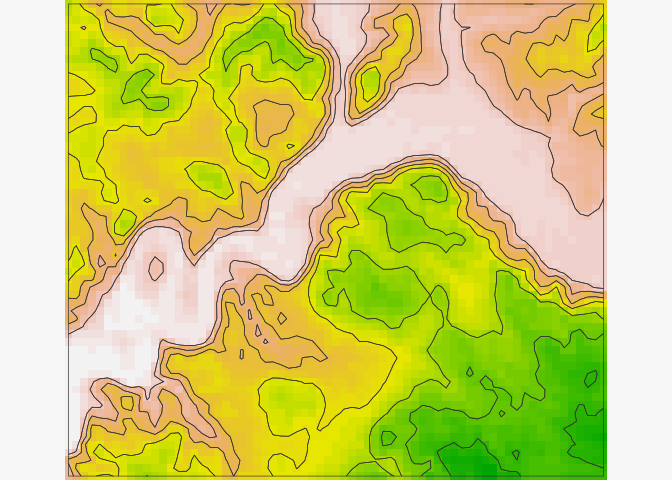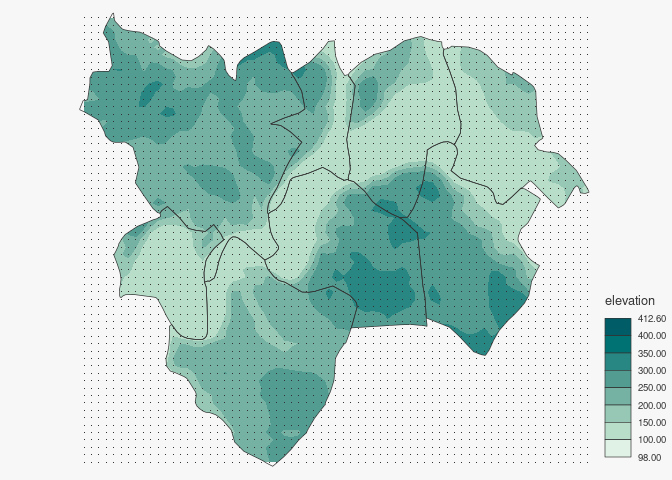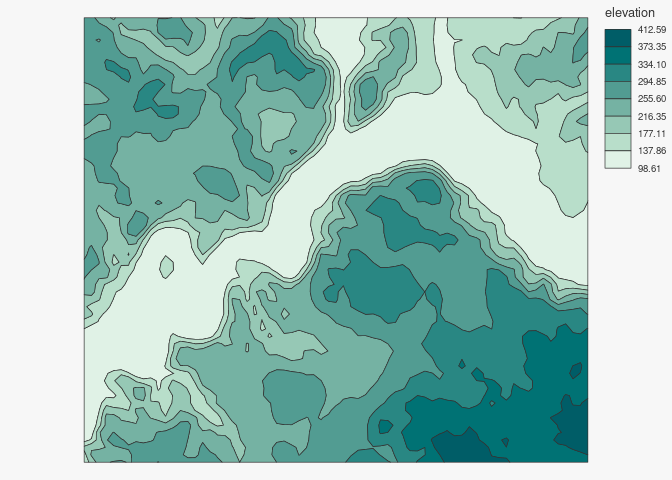

The goal of mapiso is to ease the transformation of
regularly spaced grids containing continuous data into contour polygons.
These grids can be defined by data.frames (x, y, value), sf
objects or SpatRasters from terra.
mapsio is a wrapper around isoband.
You can install the development version of mapiso from
GitHub with:
remotes::install_github("riatelab/mapiso")library(mapiso)
library(terra)
#> terra 1.5.34
library(mapsf)
r <- rast(system.file("tif/elevation.tif", package = "mapiso"))
isor <- mapiso(x = r)
mf_theme(mar = c(0, 0, 0, 0))
mf_raster(r)
mf_map(isor, col = NA, add = TRUE)
library(mapiso)
library(sf)
#> Linking to GEOS 3.9.0, GDAL 3.2.2, PROJ 7.2.1; sf_use_s2() is TRUE
library(mapsf)
# gridded data
s <- st_read(system.file("gpkg/elevation.gpkg", package = "mapiso"),
layer = "elevation", quiet = TRUE)
# mask
m <- st_read(system.file("gpkg/elevation.gpkg", package = "mapiso"),
layer = "com", quiet = TRUE)
# custom breaks
bks <-c(98,100, 150, 200, 250, 300, 350, 400, 412.6)
isos <- mapiso(x = s, var = "elevation", breaks = bks, mask = m)
mf_map(isos, "isomin", "choro",
breaks = bks, border = NA,
leg_title = "elevation")
mf_map(m, col = NA, add = TRUE)
mf_map(s, cex = 1, pch = ".", col = "grey20", add = TRUE)
library(mapiso)
library(mapsf)
d <- read.csv(system.file("csv/elevation.csv", package = "mapiso"))
head(d)
#> x y elevation
#> 1 586231.3 6431677 282.0299
#> 2 586481.3 6431677 263.7194
#> 3 586731.3 6431677 244.9597
#> 4 586981.3 6431677 222.3232
#> 5 587231.3 6431677 211.1522
#> 6 587481.3 6431677 232.1604
isod <- mapiso(x = d, var = 'elevation', coords = c('x', 'y'), crs = 'epsg:2154')
bks <- unique(c(isod$isomin, isod$isomax))
mf_map(isod, "isomin", "choro", breaks = bks, leg_title = "elevation")
One can contribute to the package through pull requests and report
issues or ask questions here.
This project uses conventional
commits and semantic
versioning.